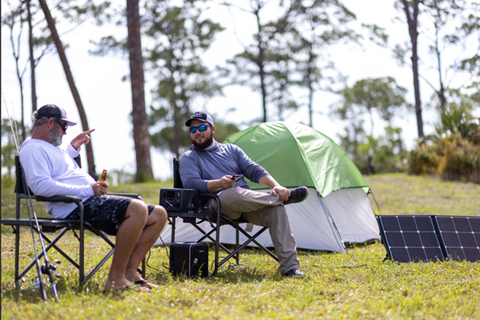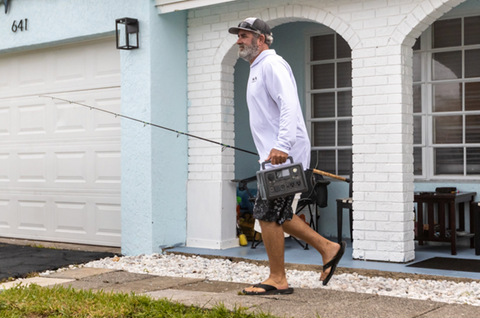Breaking away from the chaos of daily life and going out in the great outdoors is always exciting. However, if you're planning to go RVing or backpacking, a mere portable power bank may not be sufficient to sustain both you and your devices.
In such cases, a portable solar energy system is essential as it provides the freedom to travel without the need to search for a power source to charge your devices. Whether it’s powering your lights, stove, or electronic gadgets, portable solar energy systems offer comprehensive solutions.
Nevertheless, it is crucial to find a solar energy system that aligns with your specific travel style. There is no single solution that fits every situation when it comes to the optimal portable solar system. In this guide, we will take a closer look at portable solar energy systems and help you choose the right one so you can stay powered even in remote locations.
What Are Portable Solar Energy Systems?
Portable solar energy systems are self-contained setups that harness sunlight and convert it into usable electrical energy in a compact and mobile form. These systems usually comprise solar panels, a charge controller, a battery, and sometimes an inverter.
Solar panels in portable solar energy systems are lightweight and you can easily carry them around. They are made up of photovoltaic cells that capture energy from the sun and convert it into direct current electricity.
The charge controller monitors the electricity flow from the solar panels to the battery. It ensures that the battery is charged efficiently and protects it from damage and overcharging.
The battery in a portable solar energy system stores the electricity produced by the solar panels. It allows for energy to be stored during the day when the sun is shining and used later when needed, such as during the night or in low sunlight conditions. Common types of batteries used in these systems include lithium-ion, lead-acid, or lithium-iron phosphate (LiFePO4) batteries.
In some cases, portable solar energy systems may also include an inverter. The inverter converts the stored DC electricity from the battery into alternating current (AC) electricity, which is suitable for powering various electronic devices and appliances.
Why Are Portable Solar Energy Systems Perfect for Remote Locations?
Portable solar systems are well-suited for remote locations due to various reasons:
1. Energy Independence
Remote locations often lack access to traditional power grids, making it challenging to obtain electricity. With portable solar energy systems, you generate your own power, giving you energy independence and reducing your dependence on external sources.
2. Easy Installation and Mobility
Portable solar systems are lightweight, compact, and easy to install. You can quickly set them up when you reach your destination and pack them up after your adventure is over.
3. Abundant Renewable Energy
Remote locations typically have ample sunlight, which makes portable solar systems highly efficient. Solar panels harness solar energy and convert it into electricity, providing a reliable and renewable power source. Thanks to this abundance of sunlight, you can rest assured that you will have a consistent supply of energy throughout your trip.
4. Minimal Environmental Impact
Portable solar systems produce clean energy without emissions or pollution. They have a minimal environmental footprint compared to fossil fuel-based power sources. In remote locations, these energy systems preserve the natural environment and align with sustainable practices.
5. Versatility and Adaptability
Portable solar systems can power a wide range of devices and appliances, from small electronics like phones and laptops to larger equipment, such as refrigerators or lighting systems.
6. Low Maintenance
Portable solar systems typically require minimal maintenance. All you have to do is regularly clean the solar panels to remove dust or debris. This ease of maintenance is beneficial in remote areas where access to technical support or spare parts may be limited.

What Devices Can You Power with Portable Solar Energy for Your Wilderness Retreat?
Engaging in outdoor adventures in the wilderness comes with certain risks. Thus, you need to be adequately prepared for the unpredictable conditions you may encounter. Depending on the severity of the circumstances, having the right equipment is essential.
To help you out, we have compiled a list of essential camping gear that can be powered using a portable solar generator.
1. Torch
A campfire is an essential part of any wilderness retreat, but it can only do so much. It can get extinguished by rain or strong winds, and since you can only have it in one place, you won’t be able to use it if you need to move around. That said, we highly recommend investing in a high-quality camping lantern for your outdoor retreats. Not only will it ensure your safety, but you can also conveniently charge them using your portable energy system.
2. Rechargeable Lighter
With a rechargeable lighter, you can ensure a constant flame that never dies out. Unlike traditional lighters fueled by kerosene oil or butane gas, a USB-powered lighter is sufficient to generate a spark. On a full battery charge, most rechargeable lighters can provide around 150 to 200 ignitions.
3. Portable Shower
Camping in the wilderness provides some of life's most memorable experiences. However, hygiene-related challenges often arise, particularly if you are sharing the same camping spot with multiple individuals. In the absence of a shower facility at your campground, a portable shower becomes a valuable solution to keep yourself clean and refreshed.
You can use a portable shower device with rechargeable batteries that you can seamlessly connect with your portable solar power system using a USB connection. This way, you can recharge the shower device using solar energy, enjoying a continuous power supply without needing conventional electricity sources.
4. Electric Kettle
Water is essential to survive in the wilderness. However, relying on natural water sources can be risky due to potential contamination by harmful bacteria. While using boiling water is the simplest way to ensure its safety, starting a fire may not always be feasible.
Additionally, you may want to drink hot beverages to keep yourselves warm during your outdoor excursions. In such situations, it’s best that you use a portable electric kettle that you can conveniently power with a portable solar energy system.
5. Mini Fan
When the sun shines intensely, it can heat up your campsite and tent. The good thing is you can alleviate this discomfort by using a mini fan powered by your camping solar energy system. This allows you to effectively cool down your camping area, enhancing your overall comfort and enjoyment in hot weather conditions.
6. Camp Stove
Although cooking on an open fire is an option, it often proves to be a hassle. Furthermore, campfires are prohibited in many areas due to the constant risk of wildfires. Therefore, it is essential to bring along a camp stove for your camping trips.
The great news is that you can effortlessly utilize camping solar energy from your portable solar power station to fuel your stove and prepare your meals. You can harness the sun’s power to cook your food while enjoying the outdoors.

How to Choose Portable Solar Energy System for Your Wilderness Retreat
When selecting a solar energy system for outdoor adventures, several factors should be considered to ensure you choose the right one for your needs. Here are some key factors to consider:
1. Power Output
Power output is a crucial factor to consider when choosing a solar energy system for outdoor adventures. To determine your power requirements, you need to assess the devices and appliances you plan to power using the solar system.
Start by making a list of the devices you will be using during your outdoor excursions. Then, note down the wattage rating or power consumption of each device. You can find this information on the device itself or in the user manual. It is important to consider both the continuous power draw and any peak power requirements when the device starts up or operates at maximum capacity.
Add up the wattage of all the devices you plan to use simultaneously to determine the minimum power output you would need from the solar energy system. It is advisable to add a safety margin to account for fluctuations and accommodate additional devices you might use in the future.
2. Portability
A portable solar energy system should be designed with ease of transportation in mind. Look for systems that are compact and lightweight so you can easily pack and carry them along with your other camping gear. Consider the overall size, weight, and form factor of the system, as it should be convenient to fit into your backpack or vehicle without adding excessive bulk or weight.
In addition to being compact, the system should also be easy to set up and dismantle at various campsites or remote areas. Look for systems that feature quick and straightforward assembly, with clear instructions and minimal components. Ideally, it should be a tool-free setup that you can complete within minutes.
3. Battery Capacity
The battery capacity represents the amount of energy the battery can store and subsequently provide to your devices. A larger battery capacity means more energy can be stored, allowing for extended periods of power availability when sunlight is not accessible.
When assessing battery capacity, you need to consider your power requirements and the duration of power usage. Calculate the total energy consumption of the devices you plan to power and estimate how long you will need to rely on stored energy. This will help you determine the appropriate battery capacity needed to support your outdoor activities.
Having a solar energy system with ample battery capacity ensures that you have a reliable power source beyond direct sunlight. It enables you to charge and power your devices during cloudy days, overnight, or when you're located in shaded areas.
4. Compatibility
Compatibility is a crucial factor to consider when selecting a solar energy system for your outdoor adventures. It is important to ensure that the system you choose is compatible with the devices and appliances you intend to power, allowing for seamless integration and efficient operation.
Start by identifying the specific devices and appliances you plan to use with the solar energy system. Consider their power requirements, charging methods, and the type of connectors they use. Some common devices include smartphones, tablets, laptops, cameras, portable speakers, camping lights, fans, and even camping stoves or refrigerators.

Wrapping Up
Portable solar energy systems offer a reliable and sustainable solution for off-grid power in remote locations during your wilderness retreat. These systems provide the freedom to explore and enjoy the beauty of nature without sacrificing modern conveniences or compromising safety.




